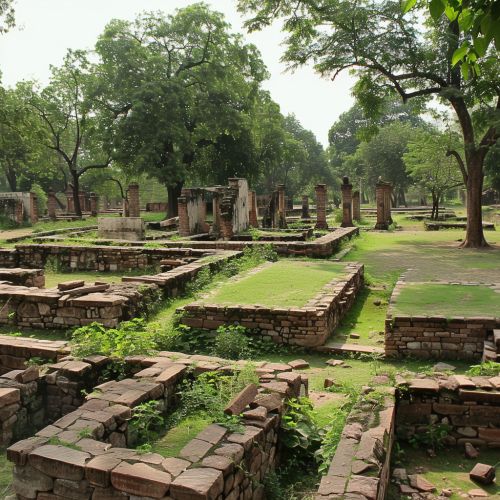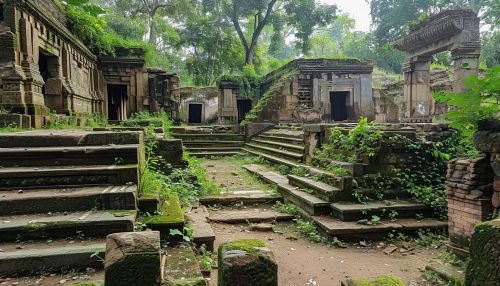Takshashila University: Difference between revisions
(Created page with "== History == Takshashila University, also known as Taxila University, was an ancient center of learning located in the city of Takshashila (modern-day Taxila in Pakistan). It is considered one of the earliest universities in the world, dating back to at least the 5th century BCE. The university attracted students from across the ancient world, including regions now known as India, China, Greece, and Persia. Takshashila was not a university in the modern sense but rat...") |
No edit summary |
||
| Line 39: | Line 39: | ||
Takshashila also offered courses in [[Politics|political science]] and [[Military Science|military strategy]]. The [[Arthashastra|Arthashastra]], attributed to [[Chanakya|Chanakya]], was a key text in this area. Students learned about statecraft, governance, diplomacy, and military tactics. | Takshashila also offered courses in [[Politics|political science]] and [[Military Science|military strategy]]. The [[Arthashastra|Arthashastra]], attributed to [[Chanakya|Chanakya]], was a key text in this area. Students learned about statecraft, governance, diplomacy, and military tactics. | ||
[[Image:Detail-91867.jpg|thumb|center|Ancient ruins of Takshashila University, with stone structures and greenery.|class=only_on_mobile]] | |||
[[Image:Detail-91868.jpg|thumb|center|Ancient ruins of Takshashila University, with stone structures and greenery.|class=only_on_desktop]] | |||
== Notable Scholars and Alumni == | == Notable Scholars and Alumni == | ||
Latest revision as of 07:01, 19 June 2024
History
Takshashila University, also known as Taxila University, was an ancient center of learning located in the city of Takshashila (modern-day Taxila in Pakistan). It is considered one of the earliest universities in the world, dating back to at least the 5th century BCE. The university attracted students from across the ancient world, including regions now known as India, China, Greece, and Persia.
Takshashila was not a university in the modern sense but rather a collection of learned men who taught students in various subjects. The city itself was a hub of intellectual activity and a melting pot of cultures and ideas. The university's curriculum included a wide range of subjects such as Vedic literature, grammar, philosophy, astronomy, medicine, mathematics, politics, and military science.
Academic Structure
The academic structure of Takshashila University was unique and decentralized. There was no single campus or central administration. Instead, individual teachers, known as acharyas, established their own schools or centers of learning. Students would seek out these teachers based on their reputation and the subjects they taught.
The admission process was rigorous, and students were expected to demonstrate a high level of intellectual capability and commitment. The duration of studies varied depending on the subject and the teacher. Some courses could last several years, while others could be completed in a shorter time.
Curriculum and Subjects
The curriculum at Takshashila University was comprehensive and covered a wide range of disciplines. Some of the notable subjects included:
Vedic Literature
The study of Vedic texts was a fundamental part of the curriculum. Students were taught the Rigveda, Samaveda, Yajurveda, and Atharvaveda. This included not only the recitation and memorization of the texts but also their interpretation and application.
Grammar
Grammar was another crucial subject, with a focus on Sanskrit grammar. The teachings of Panini, the ancient grammarian, were particularly influential. His work, the Ashtadhyayi, is considered one of the most comprehensive and scientific grammars of any language.
Philosophy
Philosophy was a major area of study, encompassing various schools of thought such as Nyaya, Vaisheshika, Samkhya, Yoga, Mimamsa, and Vedanta. Students engaged in rigorous debates and discussions to deepen their understanding of philosophical concepts.
Astronomy and Mathematics
Takshashila was renowned for its contributions to astronomy and mathematics. Scholars like Aryabhata and Varahamihira made significant advancements in these fields. The study of celestial bodies, planetary motions, and mathematical principles was an integral part of the curriculum.
Medicine
The study of Ayurveda, the ancient Indian system of medicine, was a prominent feature of Takshashila's academic offerings. Students were trained in various aspects of medicine, including surgery, pharmacology, and anatomy. The teachings of Charaka and Sushruta were particularly influential.
Politics and Military Science
Takshashila also offered courses in political science and military strategy. The Arthashastra, attributed to Chanakya, was a key text in this area. Students learned about statecraft, governance, diplomacy, and military tactics.


Notable Scholars and Alumni
Takshashila University produced many notable scholars who made significant contributions to various fields. Some of the most renowned figures include:
Chanakya
Chanakya, also known as Kautilya or Vishnugupta, was a prominent teacher and advisor at Takshashila. He is best known for his work, the Arthashastra, a comprehensive treatise on statecraft, economics, and military strategy. Chanakya played a crucial role in the establishment of the Maurya Empire and served as the chief advisor to Chandragupta Maurya.
Panini
Panini was an ancient grammarian whose work, the Ashtadhyayi, laid the foundation for the study of Sanskrit grammar. His systematic approach to grammar and linguistic analysis has had a lasting impact on the field of linguistics.
Jivaka
Jivaka was a renowned physician who studied at Takshashila. He is often referred to as the "Father of Medicine" in ancient India. Jivaka's contributions to Ayurvedic medicine and his expertise in surgery were highly regarded.
Charaka and Sushruta
Charaka and Sushruta were two of the most influential figures in the field of Ayurvedic medicine. Charaka's Charaka Samhita and Sushruta's Sushruta Samhita are foundational texts that continue to be studied and practiced in modern Ayurveda.
Decline and Legacy
The decline of Takshashila University began around the 5th century CE, coinciding with the invasions of the Huns and other foreign powers. The city of Takshashila was eventually destroyed, leading to the dispersal of its scholars and the loss of many valuable texts and artifacts.
Despite its decline, the legacy of Takshashila University endures. It set a precedent for the establishment of other ancient centers of learning, such as Nalanda University and Vikramashila University. The contributions of its scholars have had a lasting impact on various fields of knowledge, and its model of decentralized, teacher-led education continues to inspire modern educational practices.
